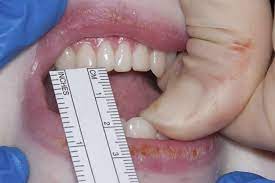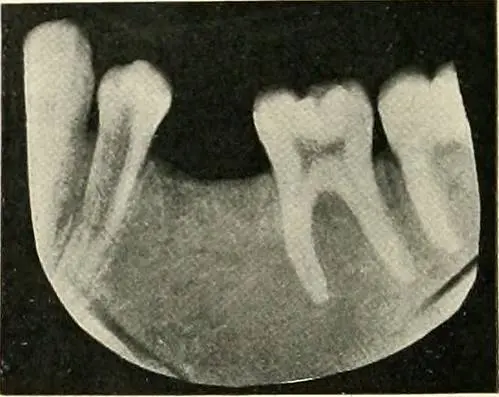If you have ever had the unfortunate experience of contracting trismus, you know just how debilitating it can be. Trismus is a condition that causes extreme difficulty opening your mouth, and can make even the simplest tasks extremely difficult. In this blog post, we will discuss what trismus is, its causes, and how you can treat it. Keep reading to learn more!
Contents
What Is Trismus?

Trismus, also known as lockjaw, is a condition that causes difficulty opening the mouth. It is caused by spasms of the muscles around the jaw, usually due to infection or injury. This can be painful and interfere with daily activities such as eating, speaking, and brushing teeth.
Causes
There are various causes of trismus. They are as follows:
- An injury to the jaw, mouth, or face
- Damage to the temporomandibular joint (TMJ)
- Infections such as tetanus, osteomyelitis or mumps
- Surgery in the face and jaw area
- Radiotherapy of head and neck tumors
- Developmental abnormalities
- Side effects of certain medications
What Type Of Physical Therapy Is Used In Trismus?
The Type of physical therapy used in trismus are as follows:
Manual stretching
This type of physical therapy involves the use of a therapist’s hands to manually stretch and relax affected jaw muscles and joints. The goal is to increase the range of motion, reduce pain, and allow for a better opening of the mouth.
Stretching exercises
These exercises are typically done at home with either a therapist or on one’s own. They may involve using a jaw exerciser, a mouth opener, resistance bands, and other tools to help stretch the jaw muscles.
Ultrasound
Ultrasound therapy is used to increase blood flow and reduce muscle tension by sending sound waves into the affected area of the jaw. The goal is to increase mobility and relieve pain.
Electrical Stimulation
This type of physical therapy uses small electrical currents to stimulate the jaw muscles, reducing spasms and providing pain relief.
Massage
Massage can help improve the range of motion by breaking up scar tissue and increasing blood flow to the area around the jaw joint.
These physical therapy approaches can be used on their own or in combination with other treatments. It is important to discuss the various options with your doctor to see which approach may work best for you. With proper treatment, trismus can be managed and its symptoms improved over time.
5 Exercises For Trismus
There are various exercises for Trismus:
Chewing exercises
This is done using specially made elastic bands or rubber bands that you stretch and move your jaw from side to side, up and down.
Active jaw stretching exercises
The steps are as follows:
- Place your thumb and index finger on the lower jaw, just in front of your ears.
- Gently pull outwards while at the same time pushing the chin upwards.
- Hold this position for 5-10 seconds, then release and relax.
- Repeat this exercise 10 times two to three times a day.
Manual jaw stretching
The steps are as follows:
- Stand in front of a mirror and open your mouth wide.
- Place your thumbs on the roof of your mouth, just behind your top teeth, and hold them there for 5-10 seconds.
- Pull down gently with your thumbs while applying slight pressure.
- Hold this position for several seconds and then release.
- Relax your jaw and repeat this exercise 10 times two to three times a day.
Chin Tucks
The method is as follows:
- Begin by sitting in a comfortable position.
- Gently tilt your head back with your chin slightly towards the ceiling.
- Keep your lips together and teeth apart as you move your lower jaw forward, tucking your chin towards your neck.
- Hold this position for five to six seconds, then release slowly and repeat the motion a few times.
Neck S Stretch
The method is as follows:
- Stand or sit comfortably with your chin tucked in and shoulders relaxed.
- Place one hand on the front of your neck and the other behind, so that you can feel the tension between them.
- Gently move your head up and down, then to the right and left while maintaining steady pressure on both sides of the neck.
- After 10 seconds, hold your head in one spot for 10 more seconds and slowly release the tension.
- Repeat this entire process at least three times per day or as often as needed to maintain flexibility in the neck muscles.
Treatment Options
There are various treatment options:
Physical therapy
Physical therapists will work to help improve your range of motion by stretching and strengthening the jaw and neck muscles. This could include exercises that focus on passive opening and closing, as well as active movement against resistance.
Medication
Non-steroidal anti-inflammatory drugs (NSAIDs) can be used to reduce inflammation and pain, while muscle relaxants can be prescribed if the trismus is caused by spasms of the jaw muscles.
Jaw Surgery
In more serious cases, surgery may be necessary to loosen the contracting ligaments around the joint and muscles.
Splints/oral appliances
These are specialized devices that are worn to help open the jaw and keep it in position for improved flexibility.
Botox injections
Injections of Botulinum toxin can also be used to relax the muscles, allowing for greater mouth opening and improved range of motion.
No matter which option you choose, it is important to discuss your specific needs with a medical professional to come up with the best treatment plan for you. With the right approach and dedication, trismus can be managed and overcome.
Preventive Tips
There are various preventive tips:
- Avoid hard or crunchy foods that require excessive chewing, like nuts and raw vegetables.
- Use gentle tooth-brushing techniques to avoid grinding your teeth or applying too much pressure when brushing them.
- Seek treatment for any temporomandibular disorder (TMD) that has been diagnosed.
- Practice relaxation techniques, like deep breathing and mindfulness meditation.
- Apply warm compresses to the jaw area for several minutes a few times each day to relieve pain and tension in the muscles.
- If you grind your teeth at night, consider wearing a mouth guard while you sleep.
- Try to avoid clenching your jaw and teeth together during stressful situations.
- Perform stretching exercises for the muscles of the face and neck regularly.
- Schedule regular dental checkups to look for any signs of trismus or other conditions that could be causing it.
Conclusion
It may be concluded that trismus is a condition that can impact the ability to open and close the mouth. It is mostly caused by an injury, infection, or surgery. Treatment will depend on the underlying cause of the trismus but may include stretching exercises, massage, physiotherapy, and/or splinting. Surgery may also be used in more severe cases. It is important to seek medical attention if you are experiencing difficulty with opening and closing your mouth. Early diagnosis and treatment of the underlying cause can help prevent long-term complications such as permanent jaw stiffness or restricted range of motion. With proper management, trismus can be managed successfully in most cases.
Physical Therapy help patients recover from pain. If you’re experiencing Back pain, Shoulder pain, Knee pain, Neck pain, Elbow pain, Hip pain, or Arthritis pain, a physical therapist at MantraCare can help: Book a physiotherapy session.


